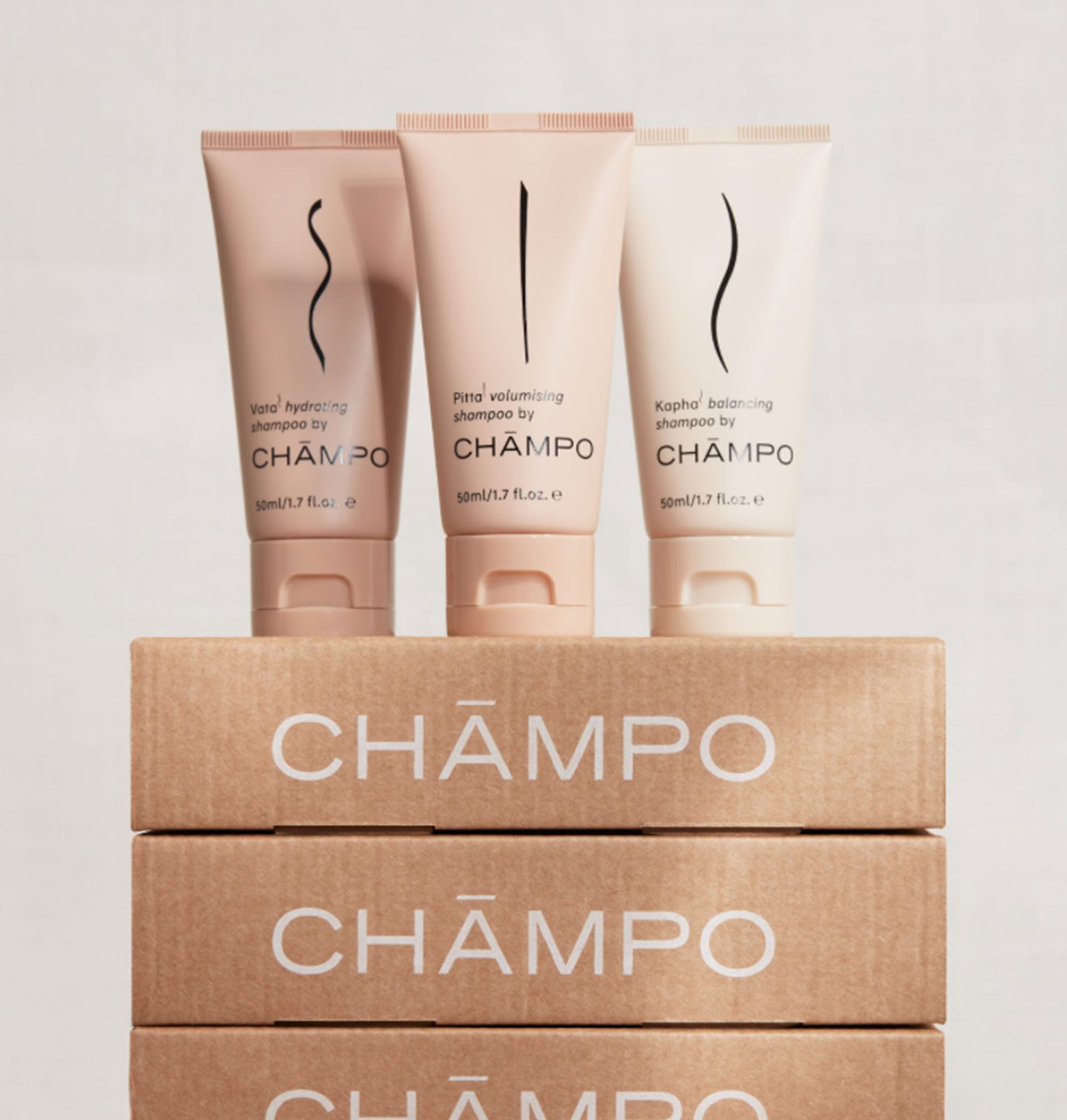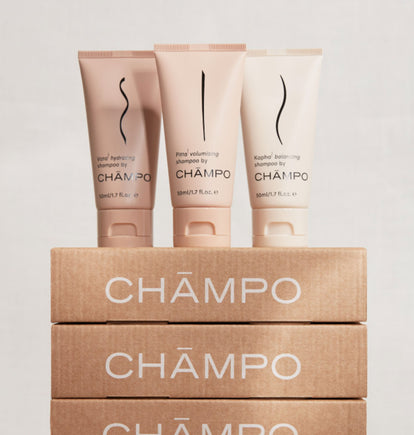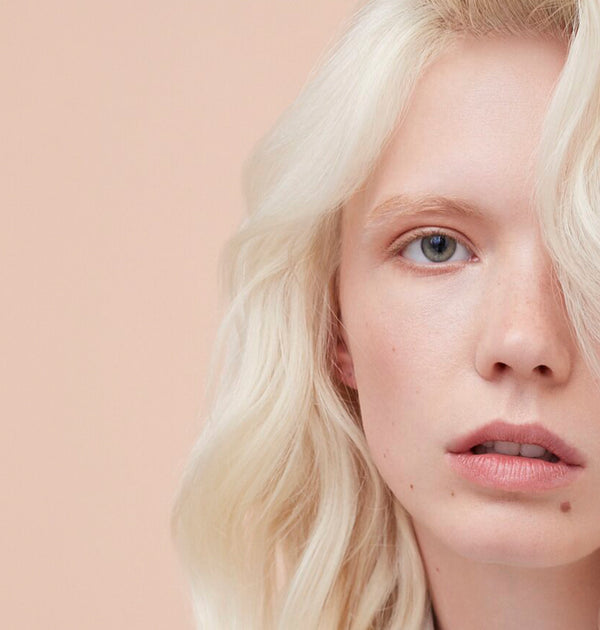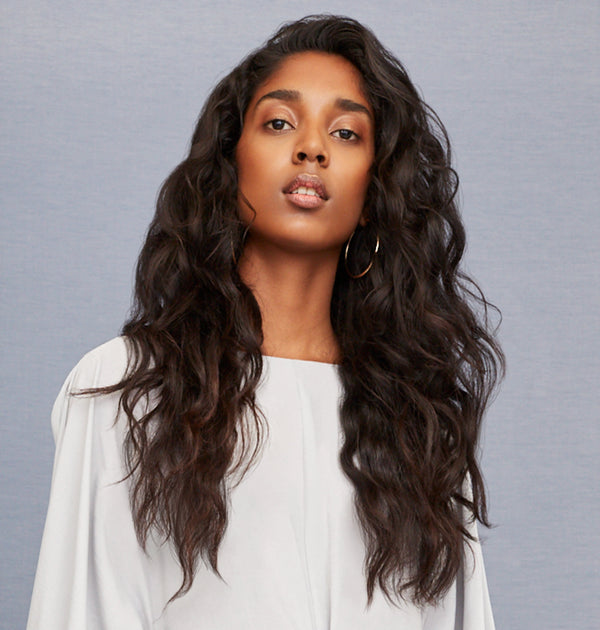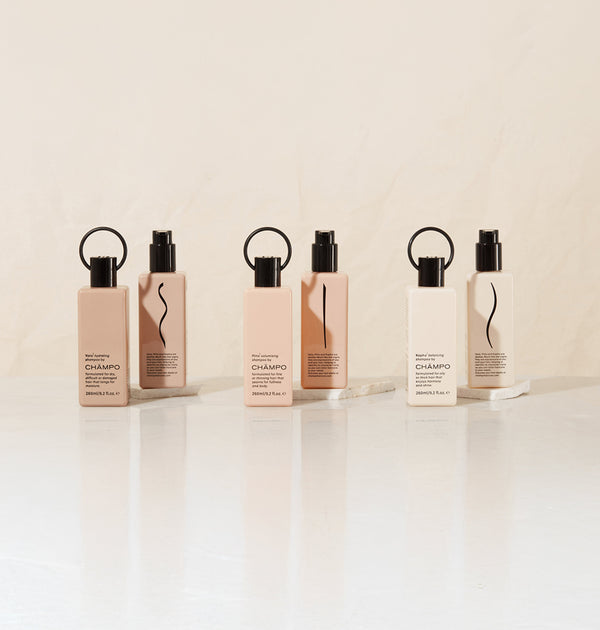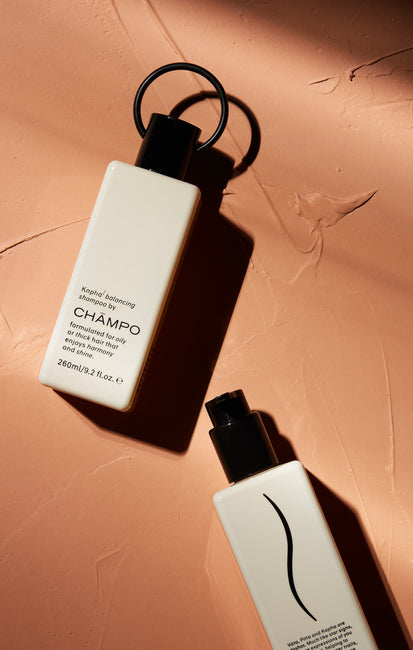Each bottle is different, targeted to a seemingly limitless number of hair types, textures and tribulations, and each making prodigious promises.
So which one (or even two) is right? And what if you don’t necessarily know your hair type?
Fine hair, thick hair, Black hair, split ends… it’s time to sweep the shelves to one side and approach things differently (and a whole lot more simply).
Despite hair’s many differences and unique traits, we believe hair can collectively be represented by one of three hair Doshas; Vata, Pitta and Kapha. Here we break down each Dosha into the different hair types, textures and conditions it embodies using standard hair type terms, and demonstrate how a simple selection from three ranges will satisfy your every hair ambition.
Vata hair is generally…
Medium-coarse texture | This refers to the width of each individual hair strand on your head. If you hold a strand of hair between your fingers and can slightly feel it, then this is medium hair.
Dehydrated | Each hair strand lacks hydration – it is porous and often appears frizzy and dull, especially on humid days. Feeding hair with proteins and amino acids will aid its absorption of water and nutrients, overcoming this issue.
Dry | Hair lacks moisture, whether due to the scalp producing less sebum or because of moisture loss through heat styling or temperature change. Coating the outer surface of each hair fibre with natural butters or oils helps form a barrier to seal moisture in.
Damaged | Damaged and dry hair may look very similar, yet they are different. Determine if hair is damaged (or dry) with a strand test – pluck one strand of hair and gently pull each end. If hair stretches successfully though doesn’t return to its previous state, it’s dry. If it doesn’t stretch or only stretches a little before breaking, it is damaged. Using a protein-rich formula on hair will help seal and smooth damaged strands.
Curly | Whether loose, medium or tight, if your hair naturally follows an S- or Z-shape, then it’s curly. Other hair Doshas can, of course, possess curly hair too, though Vata strands tends to be thicker, a challenge to style and, sadly, prone to damage.
Black hair | Abundant and with extremely tight Z-shape curls, African-American, or Afro, hair may look coarse and rough but is, in fact, soft and very fragile; requiring rich conditioners to nurture it back to health.
If this sounds familiar, then you have Vata hair. Each strand longs for gentle cleansing, to be nourished, tamed and restored to its supple, shiny and well-behaved best.
Vata hydrating shampoo and conditioner are specially formulated to answer the needs of the hair types above. Among other powerful botanicals and essential oils, it contains King Coconut – a rich source of B-complex vitamins, essential fatty acids and amino acids, plus potassium, calcium and magnesium – as well as Amla Fruit Extract, also rich in fatty acids. The result is a protein-rich formula that helps hair attract and retain moisture, reviving supple, smooth strands and manageability while prolonging shine.
Pitta hair is generally…
Fine or thin | If, when holding a strand of hair between your fingers, you can barely feel it, then your hair is fine or thin.
Thinning | Hair strands themselves become thinner and hair density reduces. Density relates to how much hair is on your scalp… if you can easily see your scalp and strands aren’t as closely packed together as they were, then you have thin hair density and are experiencing thinning. Explore this hair concern more in our hair loss and hair thinning article.
Straight | Typically lying flat from root to tip, straight hair is soft, silky and shiny – reflecting the higher level of sebum generally present on the scalp.
Wavy | Pitta hair can also have a natural wave, with strands forming a loose S-shape. When in balance, it can be tamed and easier to style, because of this characteristic. When out of balance, however, it becomes frizzy and flyaway.
Flat | Simply means that hair lies close to the head, especially so around the crown… therefore flat hair can be straight, wavy or curly.
Hair loss | A reduction in the number of hairs on your scalp. Though we lose between 100-250 strands of hair each day, if a disproportionate amount falls out when you brush, wash or run fingers through hair, then action must be taken. Explore this growing, and rather troubling, trend in our article here.
If you recognise many of the above characteristics, then you have Pitta hair. It yearns for fullness, body and control, to feel stronger, protected from breakage, and to look beautifully shiny.
Pitta volumising shampoo and conditioner are precisely blended to meet the desires of the hair types above. We chose an optimised concentration of Haritaki Fruit for our Pitta blends – a powerful active, abundant in antioxidant vitamin C, proteins and minerals. The instant result? Noticeably fuller and shinier hair that feels cleansed, nourished and strengthened. Volume builds, as does control, condition and vitality. Your natural best is, once more, restored.
Kapha hair is generally…
Thick | When holding a strand of hair between your fingers, you can distinctly feel it. Mid-lengths and ends often end up feeling coarse and therefore prove problematic.
Oily | Usually exacerbated by urban pollution, environmental influences or over-indulgence, the scalp produces a higher proportion of sebum. The level of oiliness can be identified by pressing a tissue against your scalp, especially near the crown of your head and behind your ears. The amount of oil deposited on the tissue will determine the level of oiliness of your hair. Combined with the thick texture of each strand, this excess oiliness can mean Kapha hair starts to feel uncomfortably heavy.
Wavy | Strands form a loose S-shape and, due to the thick nature of this hair type, these waves therefore feel coarse or rough in texture and are frustratingly difficult to style.
If the above hair traits are well-known to you, then you have Kapha hair. It enjoys harmony and shine, for balanced condition, control and lustre to be revived… and we have just the formulas you need.
We chose a distilled fraction of Turmeric Oil for our Kapha balancing shampoo and conditioner blends. This distinct active offers potent antioxidant and anti-inflammatory qualities, soothing and toning the scalp, restoring balance, comfort and health. Hair feels clean, but not stripped of natural oils, strands are softened, and lustre and control make a welcome return.
All hair Doshas
Before we close, it’s worth mentioning a couple of conditions that apply to all three of our hair Doshas...
Split ends |Involves the end of a strand of hair splitting into two or more parts due to the effects of chemical treatments, harsh styling and dryness. While regular trims keep split ends in check, smooth and conceal these in-between cuts by applying a little of your chosen Chämpo conditioner to the ends once hair is dry or styled.
Colour-treated |Whether bleach or block colour, any permanent chemical colour treatment will affect your hair’s condition and health. All Chämpo formulas are suitable for coloured hair, helping strands stay nourished and smooth while avoiding fading colour or brassy highlights.
In summary, haircare needn’t be as perplexing as the market makes it out to be. A simple, yet intelligent approach to formulation development will determine the right care system for you and your hair... and we firmly believe there is a Chämpo formula to fulfil your needs. Take our hair quiz, try our little ones and discover your match… we’re quietly confident you won’t be disappointed.
© 2019, all rights reserved.
